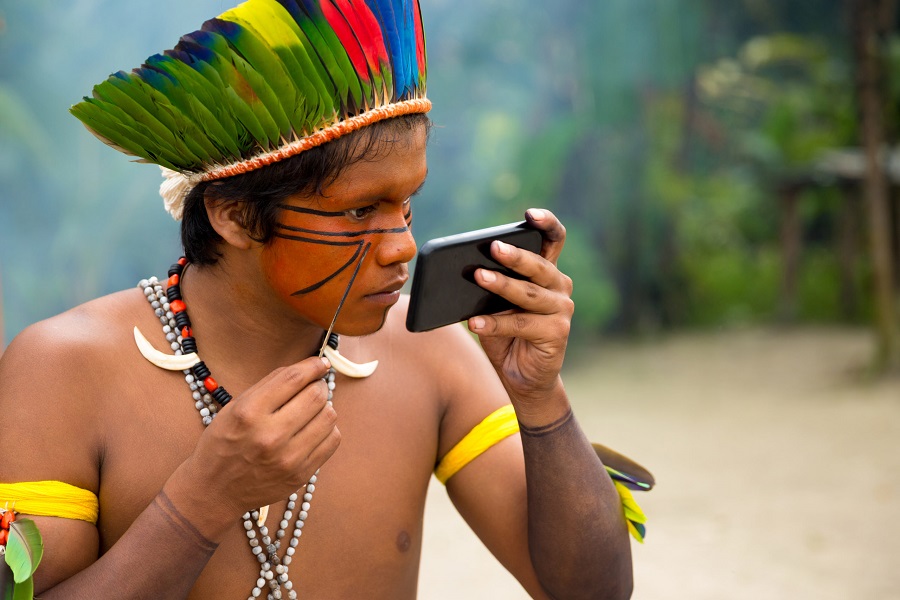RIO DE JANEIRO, BRAZIL – Xokleng is a language spoken only by one indigenous community in Vale do Alto Itajaí, in the central region of Santa Catarina state, home to over 2,000 people. A good part of the 170 existing indigenous languages in Brazil are in danger of disappearing.
For this reason, since the 1990s, linguist Namblá Gakran has been working to rescue and keep the native language alive. “I didn’t dream of being a linguist, but today I am,” he says about how he became a specialist during the struggle to preserve his people’s culture.

Gakran teaches in indigenous schools in the region and has graduated two intercultural degree classes, so that he may also teach and pass on their knowledge. The Covid-19 pandemic prevented the course from continuing this year. However, the isolation due to the health crisis also opened the door for a small initiative to spread the native language.
Since last year, the community, which lives in physically distant areas, has become closer through a Whatsapp group where they share their daily lives. Even indigenous people outside the villages, in the cities, use the channel to communicate with those who still live in the traditional territory. The only difference from the other groups of family and friends in the messaging app is that in this one it is only allowed to communicate in Xokleng. “You can’t speak in Portuguese,” says Gakran.
Consequently, less fluent people have an opportunity to practice the language, especially in text, with those who are more proficient. “People who speak more or less the language join the group and there they start to learn,” explains the teacher. In addition to facts of daily life, like fishing or a good hunt, the group becomes a space to share traditional stories. “When an opportunity arises, we tell a story from the past,” he says.
Importance of writing
Strengthening the writing of Xokleng is one of the works that Gakran has been developing over the past few years and considers fundamental to prevent the language from being lost. “What is missing is the registration of this language. It is not enough just to speak it verbally, but the community must also be able to handle this material,” he argues, while highlighting the importance of publications in the language.
It was precisely this registration work that led Gakran to become a doctor in linguistics. He says that more than 30 years ago he started recording the community’s stories, told by the elders, in partnership with an American researcher. At the time, the community was going through a process of language drift, driven by the arrival of many non-indigenous people, with the construction of the North Dam on the Itajaí River.
Today, he considers that the effort to rescue the language is producing good results. “Before we only had older speakers of the mother tongue. Today, we have monolingual children in the Xokleng language,” he says. Now, he is seeking partnerships with entities or companies that help finance publications in the native language.
According to the teacher, educational material for teaching is scarce. “We are looking for partnerships with companies and organizations so that we may develop a project that will produce material in this language,” he says.
Stories around the fire
In São Miguel das Missões, in Rio Grande do Sul, filmmaker Ariel Ortega works to rescue the oral tradition of the Guarani Mbya people, who are much more numerous and whose language is spoken in several Brazilian states. “In the morning, when we woke up, and all the daily knowledge was told around the fire, we had to pay attention,” he recalls about a tradition that has lost strength with the arrival of new activities, such as schools.
In 2007, Ortega saw the opportunity to render storytelling, with myths and past facts of the community, present itself again. “With the advent of technology, when we had access to film cameras, we learned that we could use these technologies to rescue old stories, mythologies, by talking and recording these stories by the elders,” he says.
In the beginning there was mistrust, and the filmmaker had to convince the community little by little. “In the beginning, the elders were especially careful not to talk too much. Many did not want to be recorded,” he recalls. But Ortega insisted on the need for the ancestral knowledge to be recorded. “I carefully explained the importance of this record. I told them that much of our knowledge and know-how was lost because we didn’t have access to these technologies.”
Since then, Ortega has produced 5 films, despite challenges such as the lack of resources. “We make them without any money,” says the artist, whose productions have been screened in several festivals in Brazil and abroad.
Even though he is an advocate of the use of technology, Ortega says he tries to alert younger people about the dangers of the new gadgets that are coming strongly into the villages. “Cell phone technology has many good things. But it takes away one very sacred thing: the connection with what is real, with nature. You go fishing in the river, you see the stars at night. You are no longer listening to the birds sing. You stop going to the prayer house, you stop meditating, because you focus hours on Youtube, on social networks.”
Source: Agência Brasil

